AZ-400 Exam Questions - Online Test
AZ-400 Premium VCE File

150 Lectures, 20 Hours

We provide real AZ-400 exam questions and answers braindumps in two formats. Download PDF & Practice Tests. Pass Microsoft AZ-400 Exam quickly & easily. The AZ-400 PDF type is available for reading and printing. You can print more and practice many times. With the help of our Microsoft AZ-400 dumps pdf and vce product and material, you can easily pass the AZ-400 exam.
Free demo questions for Microsoft AZ-400 Exam Dumps Below:
NEW QUESTION 1
HOTSPOT
You are configuring a release pipeline in Azure DevOps as shown in the exhibit.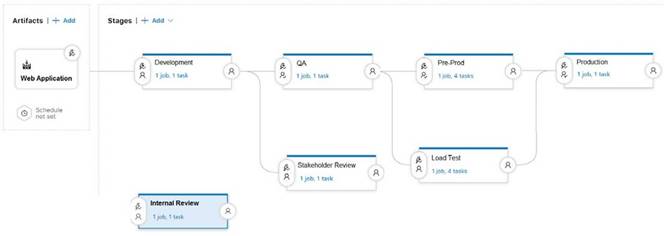
Use the drop-down menus to select the answer choice that answers each question based on the information presented in the graphic.
NOTE: Each correct selection is worth one point.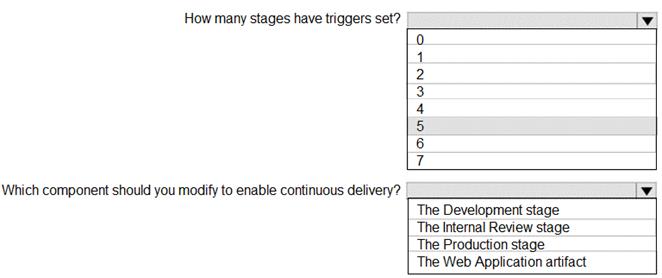
Solution:
Box 1: 5
There are five stages: Development, QA, Pre-production, Load Test and Production. They all have triggers.
Box 2: The Internal Review stage
References: https://docs.microsoft.com/en-us/azure/devops/pipelines/release/triggers
Does this meet the goal?
- A. Yes
- B. Not Mastered
Answer: A
NEW QUESTION 2
HOTSPOT
You have an Azure web app named Webapp1.
You need to use an Azure Monitor query to create a report that details the top 10 pages of Webapp1 that failed.
How should you complete the query? To answer, select the appropriate options in the answer area.
NOTE: Each correct selection is worth one point.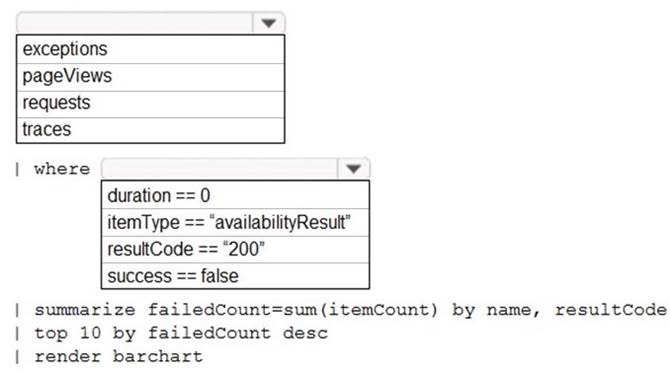
Solution:
Box 1: requests
Failed requests (requests/failed):
The count of tracked server requests that were marked as failed. Kusto code:
requests
| where success == 'False' Box 2: success == false
Does this meet the goal?
- A. Yes
- B. Not Mastered
Answer: A
NEW QUESTION 3
DRAG DROP
You plan to use Azure Kubernetes Service (AKS) to host containers deployed from images hosted in a Docker Trusted Registry.
You need to recommend a solution for provisioning and connecting to AKS. The solution must ensure that AKS is RBAC-enaWed and uses a custom service principal.
Which three commands should you recommend be run in sequence? To answer, move the appropriate commands from the list of commands to the answer area and arrange them in the coned order.
Solution:
Step 1 : az acr create
An Azure Container Registry (ACR) can also be created using the new Azure CLI. az acr create
--name <REGISTRY_NAME>
--resource-group <RESOURCE_GROUP_NAME>
--sku Basic
Step 2: az ad sp create-for-rbac
Once the ACR has been provisioned, you can either enable administrative access (which is okay for testing) or you create a Service Principal (sp) which will provide a client_id and a client_secret.
az ad sp create-for-rbac
--scopes
/subscriptions/<SUBSCRIPTION_ID>/resourcegroups/<RG_NAME>/providers/Microsoft.C ontainerRegistry/registries/<REGISTRY_NAME>
--role Contributor
--name <SERVICE_PRINCIPAL_NAME>
Step 3: kubectl create
Create a new Kubernetes Secret.
kubectl create secret docker-registry <SECRET_NAME>
--docker-server <REGISTRY_NAME>.azurecr.io
--docker-email <YOUR_MAIL>
--docker-username=<SERVICE_PRINCIPAL_ID>
--docker-password <YOUR_PASSWORD>
References:
https://thorsten-hans.com/how-to-use-private-azure-container-registry-with-kubernetes
Does this meet the goal?
- A. Yes
- B. Not Mastered
Answer: A
NEW QUESTION 4
In Azure DevOps, you create Project3.
You need to meet the requirements of the project. What should you do first?
- A. From Azure DevOps, create a service endpoint.
- B. From Sonar Qube, obtain an authentication token.
- C. From Azure DevOps, modify the build definition.
- D. From Sonar Qube , create a project.
Answer: A
Explanation:
The first thing to do is to declare your Sonar Qube server as a service endpoint in your VSTS/DevOps project settings.
References: https://docs.sonarqube.org/display/SCAN/Analyzing+with+SonarQube+Extension+for+vsts- TFS
NEW QUESTION 5
DRAG DROP
You have an Azure Kubernetes Service (AKS) cluster.
You need to deploy an application to the cluster by using Azure DevOps.
Which three actions should you perform in sequence? To answer, move the appropriate actions from the list of actions to the answer area and arrange them in the correct order.
Solution:
You can set up a CI/CD pipeline to deploy your apps on a Kubernetes cluster with Azure DevOps by leveraging a Linux agent, Docker, and Helm.
Step 1: Create a service principle in Azure Active Directory (Azure AD)
We need to assign 3 specific service principals with specific Azure Roles that need to interact with our ACR and our AKS.
Create a specific Service Principal for our Azure DevOps pipelines to be able to push and pull images and charts of our ACR.
Create a specific Service Principal for our Azure DevOps pipelines to be able to deploy our application in our AKS.
Step 2: Add a Helm package and deploy a task to the deployment pipeline This is the DevOps workflow with containers:
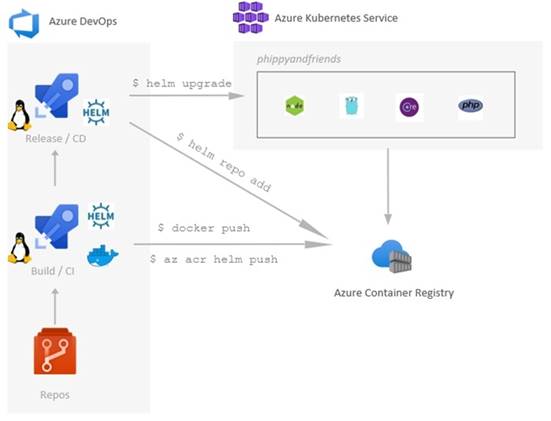
Step 3: Add a Docker Compose task to the deployment pipeline.
Dockerfile file is a script leveraged by Docker, composed of various commands (instructions) and arguments listed successively to automatically perform actions on a base image in order to create a new Docker image by packaging the app.
Does this meet the goal?
- A. Yes
- B. Not Mastered
Answer: A
NEW QUESTION 6
Note: This question is part of a series of questions that present the same scenario. Each question in the series contains a unique solution that might meet the stated goals. Some question sets might have more than one correct solution, while others might not have a correct solution.
After you answer a question in this section, you will NOT be able to return to it. As a result, these questions will not appear in the review screen.
You plan to create a release pipeline that will deploy Azure resources by using Azure Resource Manager templates. The release pipeline will create the following resources:
✑ Two resource groups
✑ Four Azure virtual machines in one resource group
✑ Two Azure SQL databases in other resource group
You need to recommend a solution to deploy the resources.
Solution: Create a main template that will deploy the resources in one resource group and a nested template that will deploy the resources in the other resource group.
Does this meet the goal?
- A. Yes
- B. No
Answer: B
Explanation:
Use two linked templates, instead of the nested template.
References: https://docs.microsoft.com/en-us/azure/azure-resource-manager/resource-group-linked-templates
NEW QUESTION 7
You have an Azure DevOps project that contains a release pipeline and a Git repository. When a new code revision is committed to the repository, a build and release is triggered.
You need to ensure that release information for the pipeline is added automatically to the work items associated to the Get commit.
What should you do?
- A. Modify the Integrations options for the pipeline.
- B. Modify the post-deployment conditions for the last stage of the pipeline.
- C. Add an agentless job to the pipeline.
- D. Modify the service hooks for the project.
Answer: A
Explanation:
Service hooks in Azure DevOps allow you to trigger actions in other tools based on events that occur in your Azure DevOps project. To automatically add release information to work items associated with a Get commit, you would need to configure a service hook that listens for commit events in your Get repository, and then sends the release information to the appropriate work items.
Here's the steps you can follow to set up a service hook for this purpose:
✑ In your Azure DevOps project, navigate to the project settings by clicking on the gear icon in the top right corner of the page.
✑ Select "Service Hooks" from the left-hand menu.
✑ Click on the "New Subscription" button to create a new service hook.
✑ In the "Event" drop-down menu, select "Code pushed" to trigger the service hook when a new code revision is committed to the repository.
✑ In the "Actions" section, select the action that you want to take place when the service hook is triggered. For example, you might use the "Link work items to commits" action to automatically associate work items with the relevant commits.
✑ Configure the remaining settings as needed, and then click on the "Create" button to create the service hook.
You can find more information on Service hooks in Azure DevOps by following this link https://docs.microsoft.com/en-us/azure/devops/service-hooks/overview?view=azure- devops
NEW QUESTION 8
You have an Azure web app named webapp1 that uses the .NET Core runtime stack. You have an Azure Application Insights resource named Applnsight1. Webapp1 sends telemetry data to Applnsights1.
You need to ensure that webapp1 sends the telemetry data at a fixed sampling rate. What should you do?
- A. From the code repository of webapp1, modify the Applicationlnsights.config file.
- B. From the code repository of webapp1, modify the Startup.cs file.
- C. From Applnsights1. modify the Usage and estimated costs settings.
- D. From Applnsights1, configure the Continuous export settings.
Answer: B
NEW QUESTION 9
You plan to share packages that you wrote, tested, validated, and deployed by using Azure Artifacts.
You need to release multiple builds of each package by using a single feed. The solution must limit the release of packages that are in development.
What should you use?
- A. global symbols
- B. local symbols
- C. upstream sources
- D. views
Answer: C
Explanation:
Views enable you to share subsets of the NuGet, npm, Maven, Python and Universal Packages package-versions in your feed with consumers. A common use for views is to share package versions that have been tested, validated, or deployed but hold back packages still under development and packages that didn’t meet a quality bar. https://docs.microsoft.com/en-us/azure/devops/artifacts/concepts/views?view=azure-devops
NEW QUESTION 10
Your company has an Azure DevOps project that produces Node Package Manager (npm) packages. Multiple projects consume the packages.
You need to minimize the amount of disk space used by older packages in Azure Artifacts. What should you modify?
- A. the retention settings of the project's pipeline
- B. the retention settings of the project's release
- C. the retention settings of the project's tests
- D. the retention settings of the company pipeline
Answer: B
Explanation:
To minimize the amount of disk space used by older packages in Azure Artifacts, you should modify the retention settings of the project's release. This can be done by navigating to the project's release settings and adjusting the retention policy. For more information, please refer to the Microsoft documentation.
NEW QUESTION 11
DRAG DROP
You have a private project in Azure DevOps and two users named User1 and User2. You need to add User1 and User2 to groups to meet the following requirements:
✑ User1 must be able to create a code wiki.
✑ User2 must be able to edit wiki pages.
✑ The solution must use the principle of least privilege.
To which group should you add each user? To answer, drag the appropriate groups to the correct users. Each group may be used once, more than once, or not at all. You may need to drag the split bar between panes or scroll to view content.
NOTE: Each correct selection is worth one point.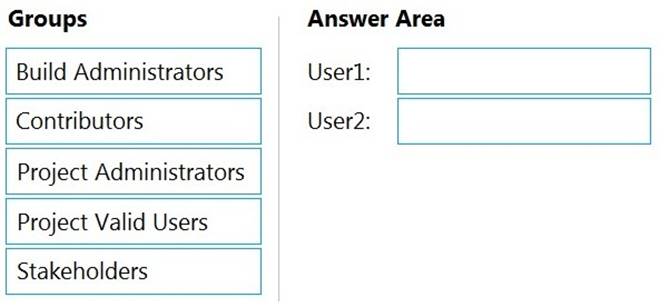
Solution:
User1: Project Administrators
You must have the permission Create Repository to publish code as wiki. By default, this permission is set for members of the Project Administrators group.
User2: Contributors
Anyone who is a member of the Contributors security group can add or edit wiki pages. Anyone with access to the team project, including stakeholders, can view the wiki.
Does this meet the goal?
- A. Yes
- B. Not Mastered
Answer: A
NEW QUESTION 12
Note: This question is part of a series of questions that present the same scenario. Each question in the series contains a unique solution that might meet the stated goals. Some question sets might have more than one correct solution, while others might not have a correct solution.
After you answer a question in this section, you will NOT be able to return to it. As a result, these questions will not appear in the review screen.
You have an Azure DevOps project.
Your build process creates several artifacts.
You need to deploy the artifacts to on-premises servers.
Solution: You deploy a Docker build to an on-premises server. You add a Download Build Artifacts task to the deployment pipeline.
Does this meet the goal?
- A. Yes
- B. No
Answer: B
Explanation:
Instead you should deploy an Azure self-hosted agent to an on-premises server.
Note: To build your code or deploy your software using Azure Pipelines, you need at least one agent.
If your on-premises environments do not have connectivity to a Microsoft-hosted agent pool (which is typically the case due to intermediate firewalls), you'll need to manually configure a self-hosted agent on on-premises computer(s).
References:
https://docs.microsoft.com/en-us/azure/devops/pipelines/agents/agents?view=azure- devops
NEW QUESTION 13
DRAG DROP
Your company has a project in Azure DevOps named Project1. All the developers at the company have Windows 10 devices.
You need to create a Get repository for Project1. The solution must meet the following requirements:
• Support large binary files.
• Store binary files outside of the repository.
• Use a standard Get workflow to maintain the metadata of the binary files by using commits to the repository.
Solution:

Does this meet the goal?
- A. Yes
- B. Not Mastered
Answer: A
NEW QUESTION 14
You are developing an iOS application by using Azure DevOps.
You need to test the application manually on 10 devices without releasing the application to the public.
Which two actions should you perform? Each correct answer presents part of the solution.
NOTE: Each correct selection is worth one point.
- A. Create a Microsoft Intune device compliance policy.
- B. Deploy a certificate from an internal certification authority (CA) to each device.
- C. Register the application in the iTunes store.
- D. Onboard the devices into Microsoft Intune.
- E. Distribute a new release of the application.
- F. Register the IDs of the devices in the Apple Developer portal.
Answer: EF
Explanation:
References: https://help.apple.com/xcode/mac/current/#/dev7ccaf4d3c
NEW QUESTION 15
You have an app named App1 that uses Application Insights to monitor application performance.
You need to analyze how often a page in App1 is accessed. Which pane in Application Insights should you use?
- A. Events
- B. Sessions
- C. Impact
- D. Users
Answer: B
NEW QUESTION 16
You have a private GitHub repository.
You need to display the commit status of the repository on Azure Boards. What should you do first?
- A. Create a GitHub action in GitHub.
- B. Add the Azure Pipelines app to the GitHub repository.
- C. Configure multi-factor authentication (MFA) for your GitHub account.
- D. Add the Azure Boards app to the repository.
Answer: D
Explanation:
To connect Azure Boards to GitHub.com, connect and configure from Azure Boards. Or, alternatively, install and configure the Azure Boards app from GitHub. Both methods have been streamlined and support authenticating and operating via the app rather than an individual.
Note (see step 4 below): Add a GitHub connection:
✑ Sign into Azure Boards.
✑ Choose (1) Project Settings, choose (2) GitHub connections and then (3) Connect your GitHub account.
✑ If this is your first time connecting to GitHub from Azure Boards, you will be asked
to sign in using your GitHub credentials. Choose an account for which you are an administrator for the repositories you want to connect to.
✑ The Add GitHub Repositories dialog automatically displays and selects all
GitHub.com repositories for which you are an administrator. Unselect any repositories that you don't want to participate in the integration.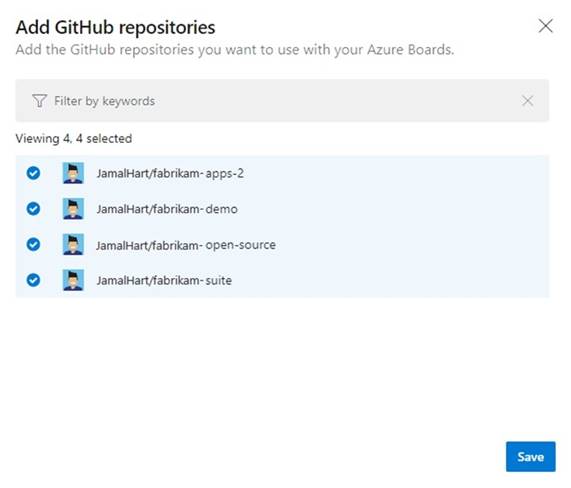
Reference:
https://docs.microsoft.com/en-us/azure/devops/boards/github/connect-to-github
NEW QUESTION 17
SIMULATION
You need to create a virtual machine template in an Azure DevTest Labs environment
named az400-9940427-dtl1. The template must be based on Windows Server 2016 Datacenter. Virtual machines created from the template must include the selenium tool and the Google Chrome browser.
To complete this task, sign in to the Microsoft Azure portal.
Solution:
* 1. Open Microsoft Azure Portal
* 2. Select All Services, and then select DevTest Labs in the DEVOPS section.
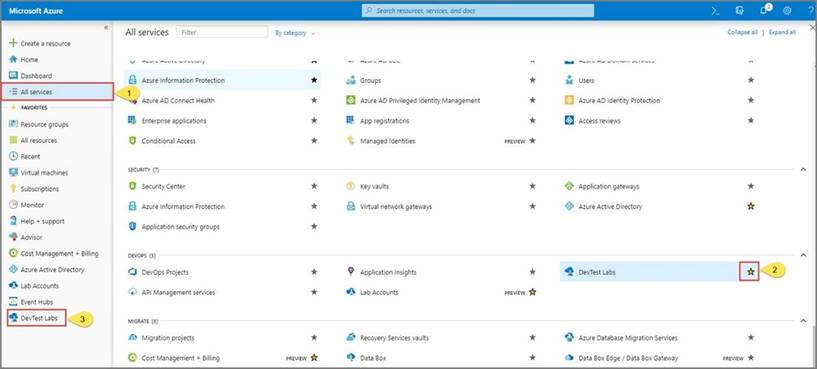
* 3. From the list of labs, select the az400-9940427-dtl1 lab
* 4. On the home page for your lab, select + Add on the toolbar.
* 5. Select the Windows Server 2016 Datacenter base image for the VM.
* 6. Select automation options at the bottom of the page above the Submit button.
* 7. You see the Azure Resource Manager template for creating the virtual machine.
* 8. The JSON segment in the resources section has the definition for the image type you selected earlier.
References:
https://docs.microsoft.com/bs-cyrl-ba/azure//lab-services/devtest-lab-vm-powershell
Does this meet the goal?
- A. Yes
- B. Not Mastered
Answer: A
NEW QUESTION 18
You have an Azure subscription that contains 50 virtual machines
You plan to manage the configuration of the virtual machines by using Azure Automation State Configuration.
You need to create the Desired State Configuration (DSO configuration files. How should structure the code blocks?
- A. Node>Configuration>Resource
- B. Configuration>Node> Resource
- C. Configuration>Resource>Node
- D. Resource>Configuration>Node
Answer: B
Explanation:
In Azure Automation State Configuration, the Desired State Configuration (DSC) configuration files are used to define the desired state of resources on a system. The structure of the code blocks in a DSC configuration file should be organized in a logical and meaningful way.
One way to structure the code blocks is as follows:
✑ Configuration: This block defines the overall configuration, including any parameters that are used in the configuration.
✑ Node: This block defines the target node(s) for the configuration, typically specified by the hostname or IP address of the target system.
✑ Resource: This block defines the resources that are managed by the configuration, including the resource type, module, and properties.
"A configuration script consists of the following parts:
The Configuration block. This is the outermost script block. You define it by using the Configuration keyword and providing a name. In this case, the name of the configuration is My Dsc Configuration.
One or more Node blocks. These define the nodes (computers or VMs) that you are configuring. In the above configuration, there is one Node block that targets a computer named TEST-PC1. The Node block can accept multiple computer names.
One or more resource blocks. This is where the configuration sets the properties for the resources that it is configuring. In this case, there are two resource blocks, each of which call the Windows Feature resource."
https://docs.microsoft.com/en-us/powershell/dsc/configurations/configurations?view=dsc- 1.1#configuration-syntax
NEW QUESTION 19
......
P.S. Certshared now are offering 100% pass ensure AZ-400 dumps! All AZ-400 exam questions have been updated with correct answers: https://www.certshared.com/exam/AZ-400/ (509 New Questions)
- [2021-New] Microsoft 70-765 Dumps With Update Exam Questions (1-10)
- Microsoft AZ-102 Exam Dumps 2021
- [2021-New] Microsoft 70-417 Dumps With Update Exam Questions (131-140)
- 100% Correct AZ-100 Free Practice Questions 2021
- Microsoft AZ-301 Braindumps 2021
- [2021-New] Microsoft 70-488 Dumps With Update Exam Questions (61-70)
- [2021-New] Microsoft 70-332 Dumps With Update Exam Questions (41-50)
- [2021-New] Microsoft 70-697 Dumps With Update Exam Questions (21-30)
- [2021-New] Microsoft 70-355 Dumps With Update Exam Questions (11-20)
- [2021-New] Microsoft 70-339 Dumps With Update Exam Questions (1-10)

